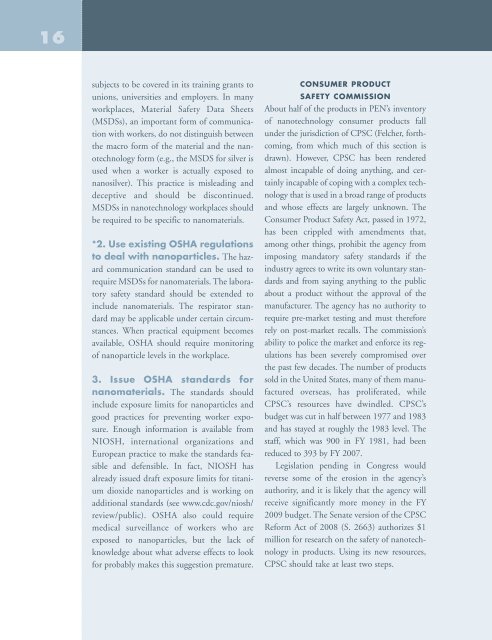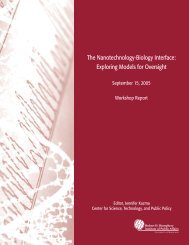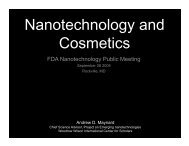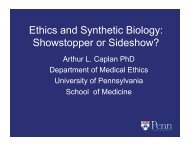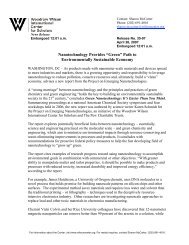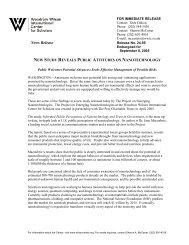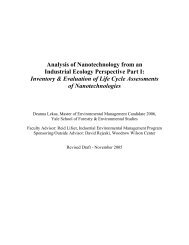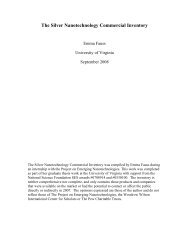nanotechnology oversight - Project on Emerging Nanotechnologies
nanotechnology oversight - Project on Emerging Nanotechnologies
nanotechnology oversight - Project on Emerging Nanotechnologies
You also want an ePaper? Increase the reach of your titles
YUMPU automatically turns print PDFs into web optimized ePapers that Google loves.
16<br />
subjects to be covered in its training grants to<br />
uni<strong>on</strong>s, universities and employers. In many<br />
workplaces, Material Safety Data Sheets<br />
(MSDSs), an important form of communicati<strong>on</strong><br />
with workers, do not distinguish between<br />
the macro form of the material and the <str<strong>on</strong>g>nanotechnology</str<strong>on</strong>g><br />
form (e.g., the MSDS for silver is<br />
used when a worker is actually exposed to<br />
nanosilver). This practice is misleading and<br />
deceptive and should be disc<strong>on</strong>tinued.<br />
MSDSs in <str<strong>on</strong>g>nanotechnology</str<strong>on</strong>g> workplaces should<br />
be required to be specific to nanomaterials.<br />
*2. Use existing OSHA regulati<strong>on</strong>s<br />
to deal with nanoparticles. The hazard<br />
communicati<strong>on</strong> standard can be used to<br />
require MSDSs for nanomaterials. The laboratory<br />
safety standard should be extended to<br />
include nanomaterials. The respirator standard<br />
may be applicable under certain circumstances.<br />
When practical equipment becomes<br />
available, OSHA should require m<strong>on</strong>itoring<br />
of nanoparticle levels in the workplace.<br />
3. Issue OSHA standards for<br />
nanomaterials. The standards should<br />
include exposure limits for nanoparticles and<br />
good practices for preventing worker exposure.<br />
Enough informati<strong>on</strong> is available from<br />
NIOSH, internati<strong>on</strong>al organizati<strong>on</strong>s and<br />
European practice to make the standards feasible<br />
and defensible. In fact, NIOSH has<br />
already issued draft exposure limits for titanium<br />
dioxide nanoparticles and is working <strong>on</strong><br />
additi<strong>on</strong>al standards (see www.cdc.gov/niosh/<br />
review/public). OSHA also could require<br />
medical surveillance of workers who are<br />
exposed to nanoparticles, but the lack of<br />
knowledge about what adverse effects to look<br />
for probably makes this suggesti<strong>on</strong> premature.<br />
CONSUMER PRODUCT<br />
SAFETY COMMISSION<br />
About half of the products in PEN’s inventory<br />
of <str<strong>on</strong>g>nanotechnology</str<strong>on</strong>g> c<strong>on</strong>sumer products fall<br />
under the jurisdicti<strong>on</strong> of CPSC (Felcher, forthcoming,<br />
from which much of this secti<strong>on</strong> is<br />
drawn). However, CPSC has been rendered<br />
almost incapable of doing anything, and certainly<br />
incapable of coping with a complex technology<br />
that is used in a broad range of products<br />
and whose effects are largely unknown. The<br />
C<strong>on</strong>sumer Product Safety Act, passed in 1972,<br />
has been crippled with amendments that,<br />
am<strong>on</strong>g other things, prohibit the agency from<br />
imposing mandatory safety standards if the<br />
industry agrees to write its own voluntary standards<br />
and from saying anything to the public<br />
about a product without the approval of the<br />
manufacturer. The agency has no authority to<br />
require pre-market testing and must therefore<br />
rely <strong>on</strong> post-market recalls. The commissi<strong>on</strong>’s<br />
ability to police the market and enforce its regulati<strong>on</strong>s<br />
has been severely compromised over<br />
the past few decades. The number of products<br />
sold in the United States, many of them manufactured<br />
overseas, has proliferated, while<br />
CPSC’s resources have dwindled. CPSC’s<br />
budget was cut in half between 1977 and 1983<br />
and has stayed at roughly the 1983 level. The<br />
staff, which was 900 in FY 1981, had been<br />
reduced to 393 by FY 2007.<br />
Legislati<strong>on</strong> pending in C<strong>on</strong>gress would<br />
reverse some of the erosi<strong>on</strong> in the agency’s<br />
authority, and it is likely that the agency will<br />
receive significantly more m<strong>on</strong>ey in the FY<br />
2009 budget. The Senate versi<strong>on</strong> of the CPSC<br />
Reform Act of 2008 (S. 2663) authorizes $1<br />
milli<strong>on</strong> for research <strong>on</strong> the safety of <str<strong>on</strong>g>nanotechnology</str<strong>on</strong>g><br />
in products. Using its new resources,<br />
CPSC should take at least two steps.


